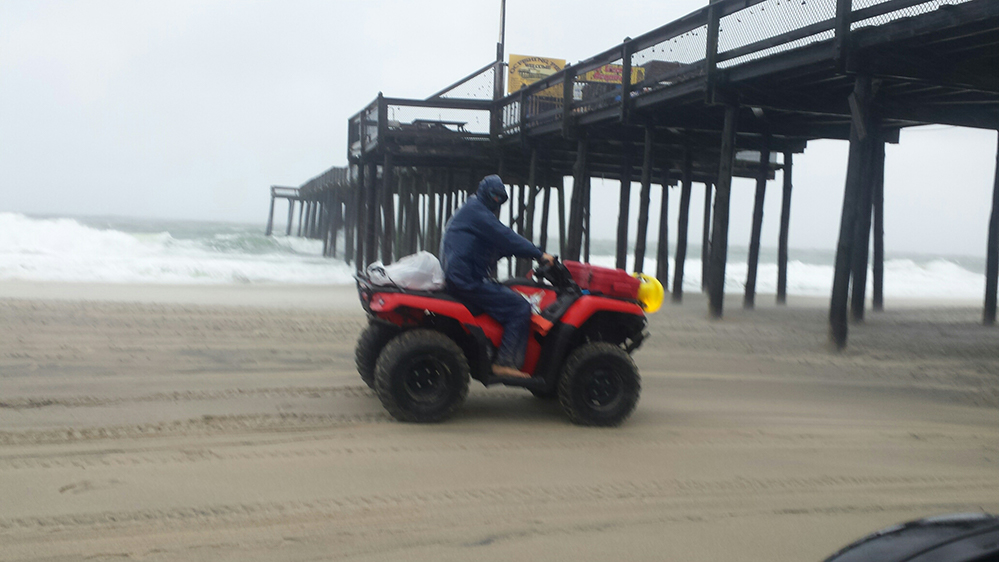ANNAPOLIS, Maryland — Maryland lifeguards and emergency managers kept a close eye on possible threats from coastal flooding and rip currents as Hurricane Dorian meandered up the mid-Atlantic coast Friday afternoon and began a projected arc out to sea.
Meanwhile, national emergency managers — including some Maryland responders — are focusing their attention on restoration efforts in the Bahamas and coastal Carolinas.
The island nation sustained significant damage from Sunday night through Tuesday afternoon; Dorian was a category 5 hurricane for around 15 of those hours, and gradually weakened.
Dorian touched down at Cape Hatteras, North Carolina, Friday morning as a category 1 storm. The landfall may deter Dorian from further intensification as “the fuel for a hurricane is warm, moist water,” said Capt. Butch Arbin, of the Ocean City Beach Patrol.
“This hurricane has been kind of unpredictable” Maryland Emergency Management Agency spokesman Jorge Castillo told Capital News Service on Friday. “A lot of emergency operation centers in Ocean City and Queen Anne’s County are now on alert.”
Two strong high pressure systems are what kept Dorian locked in place over the Bahamas for more than 24 hours, causing devastation, said National Weather Service Eastern Region Director Jason Tuell.
Dorian is expected to scoot past southeastern New England late Friday night into early Saturday morning. The National Hurricane Center has predicted that dangerous storm surge, wind and rain could span the Atlantic seaboard from the Virginia coast to Maine through Saturday.
On Thursday Gov. Larry Hogan said, “We’re going to have (tropical storm) watches for St. Mary’s County and the lower Eastern Shore, all the counties on the lower shore. We are — MEMA, Maryland Emergency Maryland Agency — is in constant communication with all of our local governments. But thankfully, we’re not going to be as impacted as many of our neighbors to the south, but it is going to be an issue for us, and we’re watching it very closely.”
The National Weather Service updated these watches into tropical storm warnings Friday morning in Maryland’s Dorchester, Wicomico, Somerset, St. Mary’s and Worcester counties, until Saturday morning, as well as coastal flood watches until late Saturday night.
In addition, boaters should be wary as tropical storm warnings extend from the Chesapeake Bay south of Tilghman Island, Maryland. Anne Arundel County, Maryland, has a coastal flood watch in effect from Saturday afternoon into Sunday morning.
The National Hurricane Center at Friday reported that Dorian’s eyewall struck North Carolina’s Outer Banks with wind gusts up to 89 mph at 8:35 a.m.
Tuell noted that even if the “hurricane stay(ed) offshore or if the eye just brush(ed) the coast, winds, heavy rain, and tornadoes” remain a threat to mid-Atlantic coastal regions. Wilmington, North Carolina, experienced at least one confirmed tornado that spawned off the northeast section of Dorian on Thursday morning, according to Tuell.
“Another thing to keep in mind as it’s raining is, land becomes saturated, trees fall over, and with winds…tree damage and power outage impacts become greater,” said Tuell. Flat, coastal plain areas such as the eastern counties of Maryland are especially susceptible to coastal flooding, said Tuell. Fuel shortages are a subsequent risk that come from power outages, said John Townsend, a spokesman for AAA mid-Atlantic.
On Thursday, Hogan deployed Maryland’s Helicopter Aquatic Rescue Team to North Carolina to assist in rescues, according to a press release.
Response and recovery crews from Maryland’s Chesapeake Chapter of the Red Cross have been deploying trained volunteers for over a week to Florida, Georgia and North Carolina.
Twenty-four volunteers from Glen Burnie to Baltimore have been “helping set up shelters, helping assess damage, feeding people and providing mental health services,” said Richard McIntire, communications officer for the Chesapeake Red Cross.
The biggest threat that Maryland beaches face are rip currents and flash rip currents, which can form in as quickly as three minutes, according to Arbin.
This type of weather event with onshore flows and swells induced by southerly winds can be a “major set-up” for rough surf and rip current risks, Tuell said.
Dangerous rip currents constitute 95 percent of Ocean City, Maryland, rescues, said Arbin.
“Normal wave action will want to fill a sand bar, moving from high tide to low tide,” said Arbin. Once the waves crash onshore, they will move parallel alongshore and converge back out a narrow channel through a sandbar “faster than an Olympic swimmer,” said Arbin.
Surfers will often use this phenomena to pull them out to bigger ocean waves, said Arbin. But less experienced swimmers will panic.
“Panic is what kills people in rip currents,” he said.
Arbin said swimmers can pinpoint rip current risk areas by analyzing where “white foam is being carried out offshore or strips of sandy water” are forming. Paradoxically, sometimes people will target these areas as their swimming go-tos because no one is there. What most people don’t realize is that rip currents are very narrow in width and a “couple good strokes (parallel to the shoreline) can get you out,” said Arbin.

